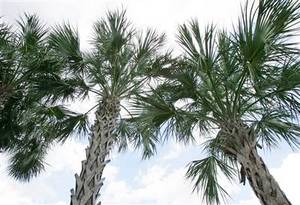
|
| ©Wilfredo Lee/AP |
| The sabal palm, Florida's state tree, is under attack by a microscopic killer that has scientists mystified. |
MIAMI - The sabal palm, Florida's state tree, is under attack by a microscopic killer that has scientists stumped.
An unknown but growing number of sabal palms in the Tampa Bay area have died from a mysterious disease that researchers are struggling to identify. Even after scientists pinpoint the disease - and that could take years - they will have to learn what insect spreads it. The disease will be tough to stop.
"It's not simply a matter that we will be able to eradicate," said Monica Elliott, a University of Florida plant pathologist. "That's not very likely."
Sabal palms, also known cabbage palms, can grow to 50 feet. In the United States, they can be found from the Florida Keys to parts of North Carolina and can grow in marshes, woodlands or along the coastline. The palm, which is also South Carolina's state tree, is featured in Florida's state seal and was designated the state tree in the 1950s.
Tim Schubert, an administrator and pathologist in Florida's Division of Plant Industry, said it's impossible to say what the disease's eventual effect on the state's sabal palms will be but "it's not going to be good."
"There's going to be fewer palms. They may present a less attractive tree in nature because of this new disease showing up," he said.
Spread of diseases
This is not the first time iconic Florida trees have been ravaged by disease. The state's orange and other citrus trees are being attacked by canker and greening. Scientists have been unable to stop either.
The new disease destroys the sabal palm and its other victims, which include Canary Island date palms and queen palms, from within. It's a tough diagnosis, Elliott said, often confused with nutrient deficiencies or excessive trimming. First to go are the lower leaves in the tree's canopy, followed by a dead spear leaf. Finally, the palm's canopy collapses.
Understanding how the disease spreads requires a trip back to high school science class.
This is a phytoplasma disease, which means it is a very small bacterium that doesn't have a cell wall. And it can only be transmitted through a plant's phloem, a type of transport tissue similar to veins in a human. The disease has likely found its way to sabal palms' phloem by either a tree- or leaf-hopping insect.
Budget woes
The disease is hitting the state during a tight budget year and University of Florida research funding has taken a hit. Officials can still turn to federal and private grants, and a proposal to dip into a small emergency fund is being considered, said Jack Battenfield, a spokesman for UF's Institute of Food and Agricultural Sciences.
"We don't have some of the freedoms we might have had before," Battenfield said. "The budget's tighter. We've got to look at things we can do most effectively, most efficiently, and have the biggest impact."



Reader Comments
to our Newsletter